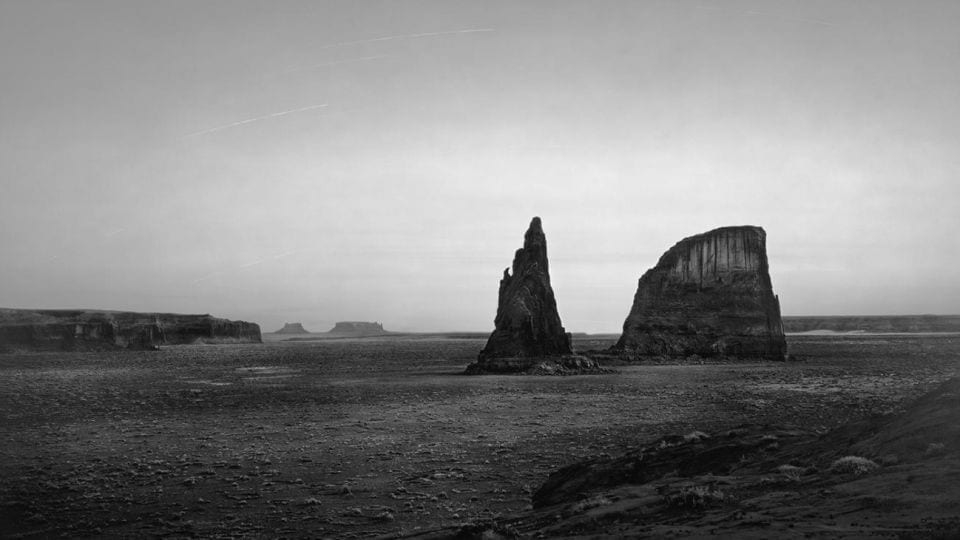Some things are not meant to be seen. But Trevor Paglen has made it his mission to highlight secret CIA prison sites, spy satellites and military installations that are designed to evade the public eye and would otherwise go unnoticed. “It’s a project to learn how to see,” he explains at Smithsonian American Art Museum, Washington, as they opened a major retrospective, the institution’s largest ever for a single artist. Rather than exposing secrets outright, Paglen focuses on the apparatus behind secrecy.
After Edward Snowden leaked secret files that revealed the US National Security Agency’s global surveillance program, Paglen photographed undersea cables and cable landing sites to show the structure behind the internet, and thus intelligence gathering. In one of the diptychs in the series, NSA-Tapped Fiber Optic Cable Landing Site, Mastic Beach, New York, United States (2015), a nautical chart indicating the location of the cables is juxtaposed with a photograph of the shorelines where the cables land and can easily be tapped. Vacationers sunbathing or frolicking under the sun are completely oblivious to what lies beneath.

“That is one of the fundamental tensions in the way that American society works, between having a military that’s many times the size of all the other militaries in the world combined on the one hand and on the other hand being a pretty open society,” Paglen notes. “That ebbs and flows and it’s not at a particularly high point at the moment, but historically it’s been better than other places.”
Whilst this exercise may seem more academic or journalistic in nature, Paglen’s work is rooted in image making. That approach allows him to find beauty in a spy satellite, creating a long-exposure photograph with vibrant red and orange hues that has an uncanny resemblance to a Kenneth Noland target painting, for 2010’s STSS-1 and Two Unidentified Spacecraft Over Carson City (Space Tracking and Surveillance System, USA 205). “For me, the most successful images have several kinds of paradoxes built upon themselves,” he explains.
Paglen’s multi-disciplinary practice also branches into sculpture. He’s planning on sending one, dubbed Orbital Reflector, into space this autumn that will be visible to the naked eye. It won’t be his first spatial adventure. In 2012, he launched a micro-etched disc containing 100 photographs encased in a gold-plated shell onto the EchoStar XVI communications satellite now orbiting the Earth beaming signals toward possible alien lifeforms. Berlin-based Paglen was among artists who installed works at the site of Japan’s Fukushima nuclear disaster in 2015, hidden from the public until the area is cleared. Trinity Cube, a replica of which is on view here, is formed of irritated broken glass collected from Fukushima and wrapped around Trinitite, a mineral created when the US exploded the first atomic bomb in New Mexico in 1945.

Turning his gaze towards artificial intelligence, Paglen reveals what computers “see,” sometimes with comical results, when they try to guess the age, gender and mood of Kronos Quartet musicians performing Claude Debussy’s String Quartet in G Minor, op. 10. No human intervenes in the communication that takes place from one machine to the next in Image Operations (2018), with their guesses superimposed on an image of the performance. Paglen has algorithms used in drones, guided missiles and self-driving cars evaluate the performers. “It’s very quantified. It can only see things that can be turned into something rational,” Paglen says of artificial intelligence. “You show a computer a (René) Magritte painting, it can’t do that. Everything has a fixed meaning for computers and what determines those fixed meanings are ultimately the people who develop the software, so you have this whole layer of interpretation that’s built into the software itself.”
Trevor Paglen: Sites Unseen, Smithsonian American Art Museum, Washington. Until 6 January. For more information, click here.
Olivia Hampton
Credits:
1. Trevor Paglen, Dead Satellite with Nuclear Reactor, Eastern Arizona (Cosmos 469), 2011, C-print. Smithsonian American Art Museum; Gift of Mike Wilkins and Sheila Duignan. Image courtesy of the artist; Metro Pictures, New York; Altman Siegel Gallery, San Francisco. © 2011, Trevor Paglen. Photo by: Gene Young.
2. Trevor Paglen, Prototype for a Nonfunctional Satellite (Design 4; Build 4), 2013, mixed media. View of an installation test at a hangar in Nevada. Courtesy of the artist; Metro Pictures, New York; Altman Siegel, San Francisco. Image courtesy of the artist and Nevada Museum of Art. © and photo by Trevor Paglen.
3. Trevor Paglen, Shoshone Falls, Hough Transform; Haar, 2017, silver gelatin print. Collection of Rory and John Maxon Ackerly. Image courtesy of the artist; Metro Pictures, New York; Altman Siegel Gallery, San Francisco. © and photo by Trevor Paglen.





